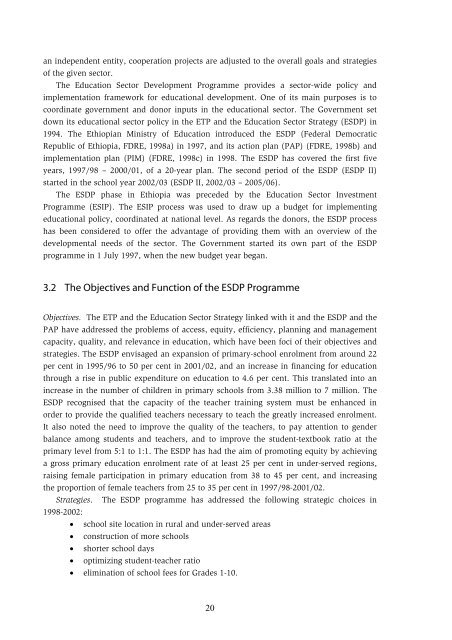Education and Training in Ethiopia An Evaluation of Approaching EFA Goals
Education and Training in Ethiopia - Koulutuksen tutkimuslaitos
Education and Training in Ethiopia - Koulutuksen tutkimuslaitos
- No tags were found...
You also want an ePaper? Increase the reach of your titles
YUMPU automatically turns print PDFs into web optimized ePapers that Google loves.
an <strong>in</strong>dependent entity, cooperation projects are adjusted to the overall goals <strong>and</strong> strategies<strong>of</strong> the given sector.The <strong>Education</strong> Sector Development Programme provides a sector-wide policy <strong>and</strong>implementation framework for educational development. One <strong>of</strong> its ma<strong>in</strong> purposes is tocoord<strong>in</strong>ate government <strong>and</strong> donor <strong>in</strong>puts <strong>in</strong> the educational sector. The Government setdown its educational sector policy <strong>in</strong> the ETP <strong>and</strong> the <strong>Education</strong> Sector Strategy (ESDP) <strong>in</strong>1994. The <strong>Ethiopia</strong>n M<strong>in</strong>istry <strong>of</strong> <strong>Education</strong> <strong>in</strong>troduced the ESDP (Federal DemocraticRepublic <strong>of</strong> <strong>Ethiopia</strong>, FDRE, 1998a) <strong>in</strong> 1997, <strong>and</strong> its action plan (PAP) (FDRE, 1998b) <strong>and</strong>implementation plan (PIM) (FDRE, 1998c) <strong>in</strong> 1998. The ESDP has covered the first fiveyears, 1997/98 – 2000/01, <strong>of</strong> a 20-year plan. The second period <strong>of</strong> the ESDP (ESDP II)started <strong>in</strong> the school year 2002/03 (ESDP II, 2002/03 – 2005/06).The ESDP phase <strong>in</strong> <strong>Ethiopia</strong> was preceded by the <strong>Education</strong> Sector InvestmentProgramme (ESIP). The ESIP process was used to draw up a budget for implement<strong>in</strong>geducational policy, coord<strong>in</strong>ated at national level. As regards the donors, the ESDP processhas been considered to <strong>of</strong>fer the advantage <strong>of</strong> provid<strong>in</strong>g them with an overview <strong>of</strong> thedevelopmental needs <strong>of</strong> the sector. The Government started its own part <strong>of</strong> the ESDPprogramme <strong>in</strong> 1 July 1997, when the new budget year began.3.2 The Objectives <strong>and</strong> Function <strong>of</strong> the ESDP ProgrammeObjectives. The ETP <strong>and</strong> the <strong>Education</strong> Sector Strategy l<strong>in</strong>ked with it <strong>and</strong> the ESDP <strong>and</strong> thePAP have addressed the problems <strong>of</strong> access, equity, efficiency, plann<strong>in</strong>g <strong>and</strong> managementcapacity, quality, <strong>and</strong> relevance <strong>in</strong> education, which have been foci <strong>of</strong> their objectives <strong>and</strong>strategies. The ESDP envisaged an expansion <strong>of</strong> primary-school enrolment from around 22per cent <strong>in</strong> 1995/96 to 50 per cent <strong>in</strong> 2001/02, <strong>and</strong> an <strong>in</strong>crease <strong>in</strong> f<strong>in</strong>anc<strong>in</strong>g for educationthrough a rise <strong>in</strong> public expenditure on education to 4.6 per cent. This translated <strong>in</strong>to an<strong>in</strong>crease <strong>in</strong> the number <strong>of</strong> children <strong>in</strong> primary schools from 3.38 million to 7 million. TheESDP recognised that the capacity <strong>of</strong> the teacher tra<strong>in</strong><strong>in</strong>g system must be enhanced <strong>in</strong>order to provide the qualified teachers necessary to teach the greatly <strong>in</strong>creased enrolment.It also noted the need to improve the quality <strong>of</strong> the teachers, to pay attention to genderbalance among students <strong>and</strong> teachers, <strong>and</strong> to improve the student-textbook ratio at theprimary level from 5:1 to 1:1. The ESDP has had the aim <strong>of</strong> promot<strong>in</strong>g equity by achiev<strong>in</strong>ga gross primary education enrolment rate <strong>of</strong> at least 25 per cent <strong>in</strong> under-served regions,rais<strong>in</strong>g female participation <strong>in</strong> primary education from 38 to 45 per cent, <strong>and</strong> <strong>in</strong>creas<strong>in</strong>gthe proportion <strong>of</strong> female teachers from 25 to 35 per cent <strong>in</strong> 1997/98-2001/02.Strategies. The ESDP programme has addressed the follow<strong>in</strong>g strategic choices <strong>in</strong>1998-2002:• school site location <strong>in</strong> rural <strong>and</strong> under-served areas• construction <strong>of</strong> more schools• shorter school days• optimiz<strong>in</strong>g student-teacher ratio• elim<strong>in</strong>ation <strong>of</strong> school fees for Grades 1-10.20




![to read the full report [pdf, Amharic] - Ethiopian Review](https://img.yumpu.com/52737829/1/190x245/to-read-the-full-report-pdf-amharic-ethiopian-review.jpg?quality=85)











